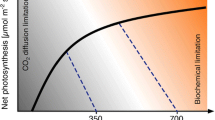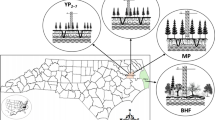Abstract
For the large-scale application of simple, aggregated models, it is important to be able to link the values of model parameters to easily measurable ecosystem characteristics. However, the aggregation of model inputs and outputs over time and space can hamper this linkage. In this paper, two temporal versions of the same simple carbon dioxide (CO2) and water exchange model, based on the concepts of water- and light-use efficiencies, were used to simulate the half-hourly and daily CO2 and water exchange of a Douglas fir forest (Pseudotsuga menziesii (Mirb.) Franco) in the Netherlands for 2 years, before and after a thinning. We tested the performance of the models and the interpretability of changes in optimized parameter values, due to the thinning, in terms of ecosystem functioning. The performance of the half-hourly model was satisfactory, whereas the performance of the daily model was high for water exchange but clearly lower for CO2 exchange. A comparison of the model parameters before and after the thinning showed that the coefficients of the half-hourly model could be separated into more physiologically determined and stand-determined characteristics, but this separation was not clear for the daily model. These results show that if the temporal resolution of the model is high enough, the effects of a major ecosystem manipulation, such as thinning, can be detected and interpreted using eddy flux data and a very simple biophysical model. The model parameters have an unambiguous interpretation and can be inferred from basic ecosystem observables, such as leaf area index (LAI) and aboveground biomass. A sensitivity analysis found strong correlations between parameter sets with similar model performance. For any comparison of the parameter values of different studies, ranges of parameter values and their correlations should be presented rather than one optimized value.
Similar content being viewed by others
Author information
Authors and Affiliations
Additional information
Received 2 May 2001; accepted 15 February 2002.
Rights and permissions
About this article
Cite this article
Wijk, M., Bouten, W. Simulating Daily and Half-Hourly Fluxes of Forest Carbon Dioxide and Water Vapor Exchange with a Simple Model of Light and Water Use. Ecosystems 5, 597–610 (2002). https://doi.org/10.1007/s10021-002-0155-z
Issue Date:
DOI: https://doi.org/10.1007/s10021-002-0155-z




